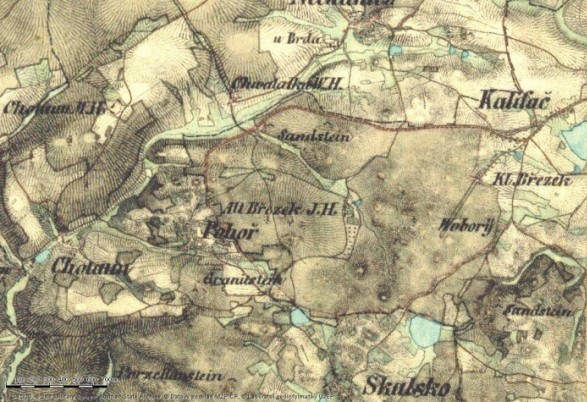
What we know about the history of the Březka Game Preserve is derived through general mentions and from a manorial declaration for the Theresian cadastre compiled in 1713. At that time, the area of forest land was about 112 hectares. The oldest document depicting the breeding of fallow deer in Březka dates back to August 1822, when Prince Rohan brought in fallow deer from Hluboká nad Vltavou. Historical sources also state that as early as 1826, there was a game preserve with a pedigree breeding herd of 150 fallow deer near the village of Březka in a particularly favorable location. In 1852, the Březka forest district had 153 hectares of forest, of which 33 hectares were set aside for agriculture.
Before the Battle of White Mountain, and until 1695, the territory of the game preserve belonged to the Lojovice estate and later to the Štiřín estate, with several successive owners, including the royal scrivener Kryštof Vratislav of Mitrovice, Viktorie Piccolomini, née Kolowratová, and others. From 1750 onwards, the Salm family, Prince Rohan, and from 1831, Count Nostic, who had the entire district enclosed by a stone wall in 1840, became the chief owners of the Štiřín estate. This created a game preserve in which 40 fallow deer were harvested annually from the 150-animal breeding herd.
In 1870, the Březka Game Preserve was acquired by the industrialist František Ringhoffer, whose family owned the estate until it was absorbed by the state in 1948. After 1948, Březka was under the control of the Czechoslovak state—the Academy of Agricultural Sciences. At that time, the Academy also managed a research institute, which evolved into the Forestry and Game Management Research Institute in 1959.
From the Ringhoffer memorial hunting book, we learned that in the late 1870s, Crown Prince Rudolf and his entourage, including the governor of Prague and other prominent personalities of that time, were also invited to Březka as hunting guests. In 1932, we saw the first record of mouflon game breeding, which numbered eight.
Important dates
Property history
| 1703 – the game preserve was bought by the Knight Karel Jindřich Mallonota de Caldes |
| 1713 – the Manorial declaration for the Theresian cadastre (area of 112 ha) |
| 1729 – the game preserve was bought by Anna Marie Alžběta Františka Serényová |
| 1751 – Count Leopold Antonín Salm-Reifferscheid buys the game preserve |
| 1760 – the game preserve was reconstructed and enclosed by a stone wall (an area of 153 ha) |
| 1801 – Countess Valperka Salmová, née Kounicová (first mention of fallow deer) |
| 1822 – Count Allain Gabriel Rohan buys the game preserve |
| 1828 – the foundation of Nová Březka |
| 1831 – the game preserve is bought by Count Ervín Nostic of Rheineck |
| 1872 – the game preserve was bought by Baron František Ringhoffer |
| 1945 – the game preserve was administered by the state forests |
| 1948 – the game preserve was taken over by the Academy of Agricultural Sciences |
| 1959 – the game preserve is administered by the Forestry and Game Management Research Institute |
History of game breeding
| On August 13, 1822, Count Allain Gabriel Rohan brought fallow deer from France and Italy |
| 1826 – fallow deer were brought from Orlík (there is a pedigree breeding herd of 150 animals in the game preserve) |
| 1893 – a hunt was organized with the participation of Archduke Franz Ferdinand d’Este |
| 1932 – mouflon game were brought in |
| 1933 – the first “golden” fallow deer of 180.45 CIC was hunted |
| 1937 – a 186.33 CIC fallow deer was hunted |
| 1980 – first fallow deer over 200 CIC (200.30 CIC) was hunted |
| 1998 – a 201.23 CIC fallow deer was hunted |
| 2010 – mouflon breeding ended |
| 2014 – a 217.70 CIC fallow deer was hunted |
| 2018 – the highest-rated fallow deer of the game preserve (228.25 CIC) was hunted |